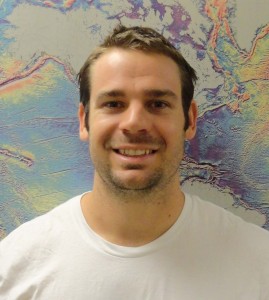Congratulations Kyle!
Kyle Withers, JDP student, was invited to give a talk at the 2016 SSA Annual Meeting in Reno and was one of five students chosen for a Student Presentation Award. This award is given to 0-15% of students presenting posters or giving talks and is based on an absolute standard of excellence and criteria. Kyle was also awarded a student travel grant to the conference.
To find out more about Kyle’s award and to watch his slidecast click here
Talk Title:
Ground Motion Variability from 3-D Deterministic Broadband (0-8 Hz) Ensemble Simulations of Mw 7.1 Strike-slip and Mw 6.7 Blind Thrust Events Incorporating Rough Fault Topography, Frequency-Dependent Viscoelasticity, Small-Scale Media Heterogeneity, and Plasticity
WITHERS, K. B., San Diego State University/University of California San Diego, San Diego, CA, USA, quantumkylew@aol.com; OLSEN, K. B., San Diego State University, San Diego, CA, USA, kbolsen@mail.sdsu.edu; SHI, Z., San Diego State University, San Diego, CA, USA, zshi@mail.sdsu.edu ;; DAY, S., San Diego State University, San Diego, CA, USA, sday@mail.sdsu.edu
Abstract
We model ground motion variability for large strike-slip and blind thrust earthquakes including frequencies up to 8 Hz. The earthquake source is obtained through dynamic rupture propagation using SORD along several realizations of rough fault topographies. An ensemble of sources is modeled by varying the hypocenter location that results in similar moment magnitudes. The slip-rate data from the rupture modeling is converted to a kinematic source and input into the wave propagation code AWP-ODC, which incorporates frequency-dependent attenuation (Q(f)) as well as Drucker-Prager plasticity. We also include small-scale medium complexity in both a 1D-layered model and a 3D medium extracted from SCEC CVM-S4 including a surface geotechnical layer. The ground motion is analyzed spatially by binning the ground motion as a function of distance and comparing with leading GMPEs. The median ground motion follows a similar decay as compared to GMPEs when using a Q(f) power-law exponent in the range 0.6-0.8. Nonlinear effects are needed to reduce near-field ground motion to observable levels in regions of near-surface low velocity layers. Small-scale media complexity is observed to decrease the polarization ratio to that of similar to observations. The intra-event variability for the layered model simulations is near observed values of single-station standard deviation. Small-scale heterogeneity can significantly affect the intra-event variability at frequencies greater than ~1 Hz, becoming increasingly important at larger distances from the source. The intra-event variability of our simulations in the CVM is typically larger than that for the observations at frequencies > 1 Hz. However, this discrepancy tends to decrease when small-scale heterogeneities are included, suggesting the need for a highly complex velocity model to fit ground motion variability. Plastic effects in the medium also reduce the variability, particularly at distances close to the source.


